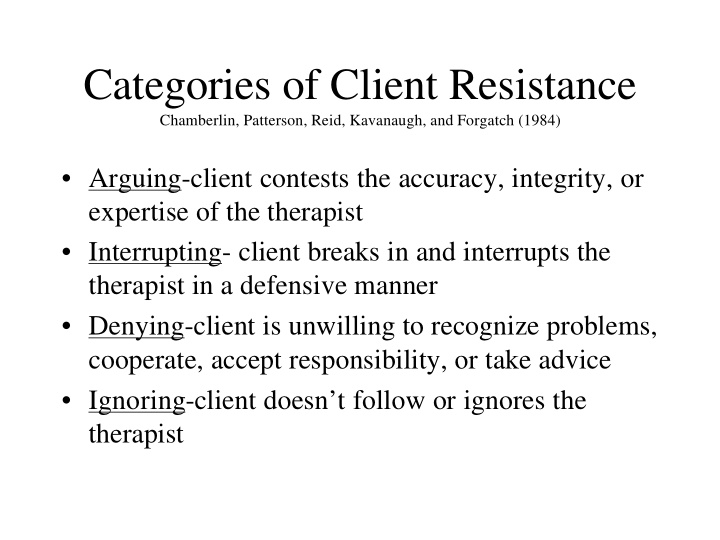



Categories of Client Resistance Chamberlin, Patterson, Reid, Kavanaugh, and Forgatch (1984) • Arguing-client contests the accuracy, integrity, or expertise of the therapist • Interrupting- client breaks in and interrupts the therapist in a defensive manner • Denying-client is unwilling to recognize problems, cooperate, accept responsibility, or take advice • Ignoring-client doesn’t follow or ignores the therapist
Arguing • Challenging-client directly challenges the accuracy of what the therapist has said • Discounting- client questions the therapists authority and expertise • Hostility- client expresses direct hostility toward the therapist
Interrupting • Talking Over- client speaks while the therapist is still talking • Cutting Off- client breaks in with word to cut the therapist off
Denying • Blaming • Disagreeing • Excusing • Claiming Impunity- client is not in danger • Minimizing • Pessimism • Reluctance • Unwillingness to change
Ignoring • Inattention • Non-answer • No response • Sidetracking
Traps • Question and Answer • Taking Sides • Expert • Labeling • Premature Focus • Blaming
Initial Approaches • Open-ended Questions • Reflective Listening • Affirmation • Summarization • Eliciting Change Talk
Eliciting Change Talk Evocative Questions – Disadvantages of the status quo – Advantages of change – Optimism about change – Intention to change
Eliciting Change Talk Exploring the Decisional Balance Elaborating Querying Extremes Looking Back Looking Forward Exploring Goals and Values
Approaches to Resistance • Reflection – Simple – Amplified-exaggerate what client has said – Double-Sided-adding the other side of the clients ambivalence • Shift Focus • Agreement with a twist • Emphasize personal choice and control • Reframing • Paradox
Sign of Readiness for Change • Decreased resistance • Decreased questions about the problem • Resolve • Self-motivational statements • Increased questions about change • Envisioning • Experimenting
Recapitulation • Summarize the clients perception of the problem • Summarize the clients ambivalence • Summarize the objective data about the problem • Restate any indications the client has made regarding change • Provide your assessment of the clients situation
Key Questions • What do you think you will do? • What does this mean about your drinking/drug use? • What’s the next step? • What do you think has to change? • What could you do? • What are your options? • How would you like things to turn out? • What concerns do you have about changing your alcohol/drug use? • What would be some of the positive things about change ?
Recommend
More recommend